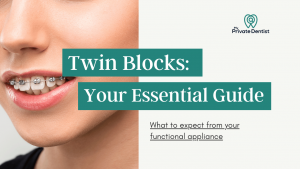If you’ve broken a tooth, and need to have it repaired, it’s not always possible to have it permanently fixed straight away.
At an emergency appointment, your dentist may place a temporary filling to seal and protect the tooth. A longer appointment can then be arranged for a permanent restoration.
Below are the main reasons for temporary fillings, and answers to common questions about this procedure.
I will also cover the usefulness of over-the-counter DIY filling materials.
What is a temporary filling?
A temporary filling is placed to seal a tooth to protect and stabilise it, while waiting for a permanent restoration. This may help to:
- Protect the nerve inside the tooth and prevent developing sensitivity
- Prevent the cavity from trapping food
- Protect your tongue from a sharp edge
When is a temporary filling needed?
An emergency appointment for a broken tooth: If you have broken a tooth and have been offered an emergency appointment at your dentist, due to time constraints they may place a temporary filling. These fillings are quick and simple to place and need less preparation than a permanent filling. They can then book you a longer appointment to have a permanent filling placed.
Deep fillings close to the nerve: If you have extensive tooth decay and may need root canal treatment, the dentist may place a temporary filling. The dentist can then assess whether the nerve inside the tooth is healthy. If you have no pain after, you can have a permanent filling. If the nerve is still causing you pain then may need a root canal treatment.
Between root canal treatment visits: If a root canal treatment is completed over two visits, you will have a temporary filling to seal the tooth after the first visit [1]. This is then easily removed to complete the root treatment.
Stabilising multiple decayed teeth: If you have extensive decay in many teeth, then it’s important to stabilise all the teeth first. All the tooth decay is removed and temporary fillings are placed. You can then work on factors causing decay such as improving diet and oral hygiene. Once habits have been improved, the fillings can be replaced with permanent restorations.
Trauma: If you’ve fallen and broken your front teeth, then the priority is to get your teeth sealed and stabilised with temporary fillings. Following this the extent of the damage from the trauma can be assessed, and decisions made on longer term treatment. The permanent restorations will be more aesthetic to restore your smile.
What are temporary fillings made out of?
They are usually made of:
- Zinc Oxide
- Glass Ionomer
- Cavit
These materials are easier to place than permanant fillings as they need less tooth preparation.
What colour is a temporary filling?
Temporary fillings are usually much whiter than teeth. They are designed NOT to match in with your teeth so can be more easily removed without damage to your tooth.
Composite permanent fillings are colour matched to your tooth before placement. If your filling is silver, this is a permanent amalgam filling.
How long do temporary fillings last?
A temporary filling will usually last between 4 to 8 weeks, but can last longer. You should not leave a temporary filling in for too long, as it has a weak seal that can leak, become sensitive and lead to further decay. The sooner it is replaced with a permanent filling the better.
What does a dentist do for a temporary filling?
A temporary filling is most commonly placed after a tooth or filling has broken. This is because you have decay in the tooth or have bitten on something hard.
You may be seen on a short emergency visit if this happens.
If the tooth can be fixed dentist will:
- Give you an injection with local anaesthetic if necessary
- Clean the tooth to remove any food trapped or decay
- Smooth any sharp edges
- Dry the tooth, place the temporary filling material and shape it
- Give you instructions on how long to not eat or drink while the filling sets (usually 1-2 hours)
Is it painful to have a temporary filling?
A dentist will always try to make every treatment painless, and give you local anaesthetic if needed. If the dentist thinks cleaning the tooth will be sensitive, they will give you an injection first. Most of the time the placement does not require anaesthetic.
What should I avoid after having a temporary filling?
There are certain precautions you should take to avoid your filling breaking or being dislodged.
- Don’t eat or drink for 2 hours: this is to make sure the filling has time to bond to the tooth and set.
- Avoid eating hard or sticky foods e.g candy or toffees
- Keep the area clean by brushing.
- The dentist may advise you NOT to floss the area as this may dislodge the filling.
Recovery and pain relief
Most of the time there is no pain after having a temporary filling. However, you can take some painkillers if the tooth is causing discomfort.
If the tooth causes severe pain which keeps you awake at night you should return to the dentist.
How much do temporary fillings cost?
A temporary filling costs around £50-£80. The cost of an emergency appointment may be on charged in addition to this.
Can I put in a temporary filling myself?
There are some over-the-counter filling kits available. If you cannot get to the dentist you may attempt to place a temporary filling yourself.
The usefulness of these are quite limited as a tooth needs to be cleaned and dried before a filling can be placed. They are can be used as a very short-term solution if the broken tooth has a sharp edge which is digging into your cheek or tongue.
They can be useful if you’re travelling and know that it may be difficult to get the help of a dentist if you were to break a tooth or lose a filling. However they are generally a poor option, as they do not seal a tooth well, and can come out within a few hours.
What would happen if I don’t get a temporary filling replaced?
It is difficult to predict how long the filling will last. If the filling is leaking bacteria could be getting underneath it, causing further decay and damage to the tooth. This could mean it would need more extensive treatment or extraction.
What if my temporary filling falls out or breaks?
If a filling falls out or breaks its best to call your dentist as soon as possible. They will tell you whether the temporary filling needs to be replaced, or move forward your permanent filling appointment if possible.
What should I do now?
Do you need a filling? If you’ve broken your tooth or lost a filling its best to contact a dentist. They can assess your tooth and provide you with the most appropriate treatment.
Find a dentist who can help you today.




2 Comments
Lisa Cramer
March 22, 2024I broke my front tooth and it is loose now, I couldn’t get into dentist that day so bought temporary filling stuff on Amazon 1 day shipping. They are little white balls, heat them in water and they melt almost to liquid… Anyway did that placed and stuck front and back of front but it ended up covering partly roof of mouth. Starting from left front, I pressed and trying just to get it to stick ,stuck it to tooth next to it and eye tooth as well just to get front tooth I thought to not move and be stable, every time i ate even my tongue hit it, it hurt ,now my gums are swelling around, and can’t get it off is anything safe that could dissolve it. Every time I pull ,trying to loosen it up ,get it off ,it’s pulls on my front tooth and hurts so bad, Is there anything I can do ,to get it off besides seeing a professional, I don’t have the money it will cost.
Dr Jarri Amini
March 22, 2024Hi Lisa. It sounds like you used the temporary tooth repair beads to try and repair your tooth. Having read around the subject, it’s best to try and gently heat the material again using a damp warm cloth to soften it again. Be careful to make sure it’s not too hot. You can then use floss (folded over a few times to strengthen it) and then thread under the filling and between the filling and the gum. You may be able to then apply a small amount of force downwards to remove the filling material. A few people have had similar problems. See this post to see what they did https://www.amazon.com/ask/questions/Tx2EVTLBGRLF81H/. Hope this helps.